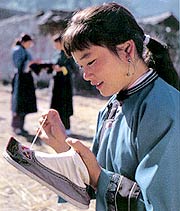 Guo Xiuming, 65, is racing against time to preserve her mother tongue, Gelo, which is spoken by only several hundred out of 430,000 Gelo ethnic people in southern China.
Guo Xiuming, 65, is racing against time to preserve her mother tongue, Gelo, which is spoken by only several hundred out of 430,000 Gelo ethnic people in southern China.
Moreover, Guo, a resident in Longlin Country in south China's Guangxi Zhuang Autonomous Region, is only one of the several dozens of people that can speak Duoluo, a dialect of the Gelo, in just several villages in the region and some places in southwest China's Guizhou Province.
"I've been collecting Gelo folk cultural heritage from senior Gelao people in Guangxi since 1995, and so far I've compiled a collection of 70,000 words about that," she told Xinhua.
The cultural heritage covers almost everything from astronomy, geography, custom, habits and folktale, which has a history of about 2,000 years.
The Gelo language is one of the 3,000 languages which have been listed by the United Nations as endangered languages and they are likely to disappear this century if necessary measures are not taken timely.
Those languages, about half of the 6,000 languages currently spoken by human beings, are dying at a speed twice as much as that of mammals, and four times that of birds, according to an estimation made by United Nations.
Some experts believed the introduction of Internet might have quickened the pace of extinction of many languages as online information is written in only few universal languages.
The State Ethnic Affairs Commission, directly under the Chinese central government, the Chinese Academy of Social Sciences and the United Nations Educational, Scientific and Cultural Organization (UNESCO) are cooperating to preserve Gelao and nine other languages now on the verge of extinction in China.
Experts with the Chinese Academy of Social Sciences have been conducting field investigation of the dying languages.
An official with the State Ethnic Affairs Commission said, "We will use digital recorders, video cameras and other methods to systematically collect the sounds, grammatical structures, basic words and expressions, folk tales of the dying languages."
Professor Qin Guosheng with the Guangxi Institute of Ethnic Minorities, an expert of languages spoken by ethnic groups, said," languages are a kind of carrier for culture, the diversity of languages is as important for mankind as biodiversity."
Ma Yongquan, a folk artist of the Zhuang ethnic group, the most populous ethnic group in the region, said he has been recording a lot of folk songs in the Zhuang language.
"The peculiar lingering charm and rules and forms of the folk songs could not be expressed in any other written language."
A dozen other ethnic groups in the region are doing the same to preserve their own culture.
Qin Yaowu, vice director of the Guangxi Language Work Committee, said Guangxi plans to set up language data for languages spoken by ethnic groups, including folk songs, proverbs, idioms and folk tales
There are 55 ethnic minority groups in China, and all have their own ethnic written languages with the exception of Hui and Manchu, which use Chinese.
Under the Chinese Constitution and the Law on Languages in Common Use, all the ethnic groups enjoy the freedom of using and developing their own languages in both oral and written forms.
The Chinese government has helped 12 ethnic minority groups without their own written languages develop a total of 16 languages, using the Latin alphabet since 1949, when the People's Republic of China was set up.
The central government also helped six other ethnic groups improve their language systems.
In China's major political activities, including the annual conference of legislators, important documents are offered in several of the most commonly used languages in China.
There are nearly 100 government-run newspapers and journals published by publishing houses specializing in minority languages.
Local and national radio and television broadcasting corporations, also provide programs in many languages for different ethnic groups, such as Tibetan, Uygur and Mongolian.
In an era of information technology, the Chinese government has also facilitated the country's 11 major ethnic groups to develop their own language coding standards, which paves the way for computer input and transmission. And some of the standards have won national and international recognition.
(Xinhua 06/25/2001)
